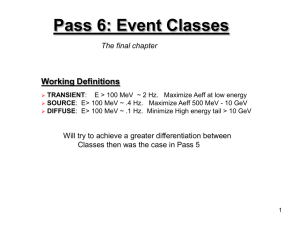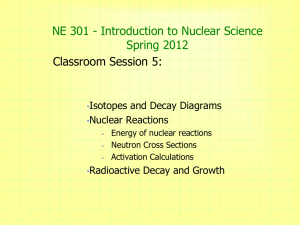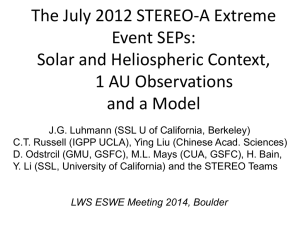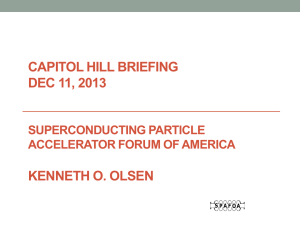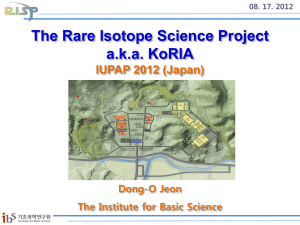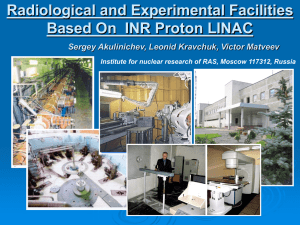At the End of the Nuclear Map
advertisement
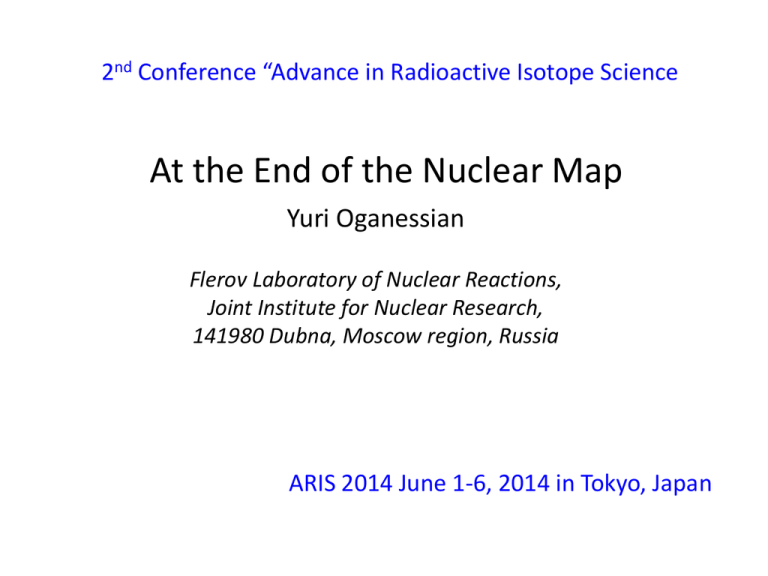
2nd Conference “Advance in Radioactive Isotope Science At the End of the Nuclear Map Yuri Oganessian Flerov Laboratory of Nuclear Reactions, Joint Institute for Nuclear Research, 141980 Dubna, Moscow region, Russia ARIS 2014 June 1-6, 2014 in Tokyo, Japan Chart of nuclides Macroscopic theory (Liquid Drop Model) about 50 years ago… proton number 120 TSF = 2·10-7 y 110 102No Nuclear instability against spontaneous fission / Tα ≈ 2 s 100 Th 90 Bi 92U / Tα = 4.5·109 y TSF = 1016 y 80 82Pb / stable 70 110 120 130 140 150 160 170 180 neutron number Yuri Oganessian. ARIS 2014, June 5, 2014 in Tokyo, Japan 190 New lands New lands -5 0 Proton number 120 Macro-microscopic theory 5 1µsabout 40 1s years 1h ago… 1y 10 15 1My Island of Stability Shoal shoal 110 Peninsula peninsula 100 90 A. Sobiczewski et al (2003) LogT1/2 s Continent continent Sea of Instability 80 70 100 110 120 130 140 150 160 Neutron number 170 180 190 Reactions of Synthesis A. Sobiczewski, K. Pomorski, PPNP 58, 292, 2007 120 LDM + Shell Corrections SHE protons → (10y) 6 elem. 1989 - 2010 110 Cold fusion -7 48Ca Act. Act. ++ 48 Ca (38y) 6 elem. 1974 - 2012 -5 -6 Hot fusion -4 -5 - 1975 (20y) 6 elem. 1955 100 -6 -3 -4 capture Neutron -3 1940 - 1955 (15y) 8 elem. -2 -4 90 U Th Historical background: -2 After discovery of nuclear fission 75 years ago - 26 new chemical elements heavier than uranium was synthesized Pb Pb Bi-14 neutrons → 80 120 130 140 150 Yuri Oganessian. ARIS 2014, June 5, 2014 in Tokyo, Japan 160 170 180 190 P. Moller et al., PR., C79, 064304 (2009) hot fusion SHE 120 48Ca-induced reactions Ex = 35 - 45 MeV х =3–4 Proton number Z 118 117 116 114 115 113 112 113 112 110 110 106 108 104 1 cold fusion 2 Fission barrier heights MeV Bf in (MeV) 3 4 5 6 7 8 100 Ex = 12 - 15 MeV х =1 Total EVRs cross sections (cm2) 208Pb, 209Bi + 50Ti,……70Zn 10-32 160 170 Rf 180 Neutron number N Sg 10-34 Hs Hs Fl Cn Fl Ds 10-36 Cn 10-38 48Ca Lv Island 113 155 160 165 170 175 185 180 CN neutron number 190 Ex=12-15 MeV 104 102 100 SHE Z1·Z2/(A11/3+A21/3) 10-2 300 250 200 150 100 Limitation of fusion 105 110 115 120 Atomic number Yuri Oganessian. ARIS 2014, June 5, 2014 in Tokyo, Japan Total EVR’s cross sections (pb) Cold fusion Bn – Bf (MeV) Total EVR’s cross sections (pb) 106 106 Hot fusion 104 Ex≈ 40 MeV 102 SHE 100 10-2 0.5 0.0 -0.5 -1.0 -1.5 -2.0 100 CN survival ~ exp(Bn-Bf) 105 K. Siwek-Wilczy´nska et al., PR C86, 014611 (2012) 110 115 120 Atomic number 1998 - 2007 Experimental technique position sensitive strip detectors Dubna Gas-Filled Recoil Separator “veto” detectors TOF-detectors Transmission for: EVR 35-40% side detectors SH recoil target-like 10-4-10-7 projectile-like 10-15-10-17 recoils 48 Registration efficiency: for α-particles 87% for SF single fragment 100% two fragments ≈ 40% Ca-ions gas-filled chamber beam 48Ca rotating entrance window target 0 22.5 detector station 249Bk focal plane detector array separator target 9.96 MeV 22.04 mm 48Ca a 1 10.91 MeV 53.01 ms 289 22.16 mm 115 a2 281 117 ER=7–15 MeV y=y0 10.7–11.4 MeV ≤ 132 ms Δy=y1-y0 ≤ 2.2 mm 10.25 MeV 0.51s 22.20 mm 285 a3 293 113 9.79 MeV 0.24 s 22.09 mm 111 SF 189.4 MeV 31.66 s 22.01 mm the beam was switched off Yu. Oganessian 2010 low-background detection scheme Spectra of fission-like signals 117 beam-on 1680 h 211Po α1 beam-on 1680 h 214Po 213Po (α+e-) 212Po (α+e-) 113 115 α2 α3 SF 111 212Po beam-off 80 h 252,254Cf 80 h beam-off 10-3/s per strip / position 2·10-6/s 7·10-5/s 1.5·10-7/s Expected numbers of random sequences ≤ 5·10-10 Yuri Oganessian / Seminar at Tokyo Institute of Technology, June 04, 2014 , Tokyo, Japan Yu. Oganessian 2010 Spectra of the α-like signals Decay Properties of SHN Even-Z Nuclei 3n 245Cm + 48Ca 2n 4n 3n 238U + 48Ca 294 118 3n 112 110 108 106 104 2n 244Pu 249Cf + 4n 48Ca 11.65(6) MeV 5n 290 0.69 +0.64 ms 291 -0.22 116 114 + 48Ca 3n 4n Z=118 242Pu Lv 10.19(6) MeV 10.02(6) MeV 282 012 +0.04 s 283 0.48 +0.16 s -0.02 -0.9 Cn N=26 9.54(6) MeV 279 9.33(6) MeV Ds 3.8 +1.2 -0.7 s 275 9.70(6) MeV Hs 0.20 +0.05 -0.04 s 9.30(6) MeV 271 +0.22 Sg 0.19 -0.07 s 8.54(8) MeV 267 1.9 +2.4 min -0.6 Rf 1.3+2.3 h 3 26 3n 3n 293 Lv Fl 0.82 +0.33 -0.18 ms + 48Ca 292 10.85(7) MeV 10.74(7) MeV 286 8.3 +3.5 ms 287 18 +22 ms -1.9 -6 Cn 244Pu 4n Lv Fl + 48Ca Lv 10.66(7) MeV 288 Fl +16 -6 10.54(6) MeV 289 Fl +57 -20 9.94(7) MeV 9.82(5) MeV 284 0.80 +0.27 s 285 9.48(8) MeV -0.16 Cn Cn 2.6 +1.2 -0.7 s +31 9.15(5) MeV 19 97 -19 ms 281 +13 Ds 29 -7 s +5 11 10 -3 s Decay chains Even Z Nuclei 1999 - 2005 Energy spectra of alpha particles 249Cf + 48Ca Counts / 20 keV 2 242Pu+ 48Ca 294118 244Pu+ 48Ca 0 2 290Lv 286Fl 3 0 9.5 10.5 Energy (MeV) 1 0 287Fl 2 0 288Fl 3 0 0 8.5 293Lv 1 0 0 2 292Lv 291Lv 1 11.5 283Cn 3 289Fl 0 8.5 0 9.5 10.5 Energy (MeV) 11.5 285Cn 2 0 279Ds 1 0 275Hs 1 0 271Sg 1 8.5 9.5 10.5 11.5 Energy (MeV) Yuri Oganessian. ARIS 2014, June 5, 2014 in Tokyo, Japan 8.5 9.0 9.5 10.0 10.5 11.0 11.5 Energy (MeV) Alpha - decay Alpha decay energy (MeV) 12.0 Theory: Theory I. Muntian, Z. Patyk, and A. Sobiczewski Z-even 118 Phys. At. Nucl. 66, (2003) 11.0 116 10.0 114 108 112 9.0 106 110 Exp. Exp: 8.0 7.0 260 Z-even Z-even 270 280 290 Atomic mass number 300 Spontaneous fission even-even isotopes 16 N=152 14 Th. R. Smolańczuk, PR. C 56 (1997) 812 N=184 Log TSF (s) 12 10 Z=98 SHN N=162 8 6 Z=112 100 4 2 102 0 108 114 104 -2 112 106 -4 114 SF critical zone -6 -8 145 150 155 160 Yuri Oganessian. ARIS 2014, June 5, 2014 in Tokyo, Japan 165 170 175 180 Neutron number Cf-No Rf Sg Hs Cn Fl 185 130 Congress of IUPAC-2011 Fl a Lv SHE 200 Yuri Oganessian. ARIS 2014, June 5, 2014 in Tokyo, Japan 210 Odd-Z Nuclei February, 2012 GARIS DGFRS 243 209 70 Bi + Zn 237 48 113 Rg Mt 10.65-11.31 MeV 12 +15 -4 ms 10.03-10.26 MeV +0.57 Bh 0.48 -0.17 s 9.08-9.77 MeV 262 2.1 +2.5 s -0.7 266 Db 39 +46 -14 s [2] 293 294 117 117 288 113 113 289 113 113 10.12-10.23 MeV 9.10-10.11 MeV 9.47-10.18 MeV 9.61-9.75 MeV 10.63(8) MeV 278 73 +134 ms 279 75 +136 ms 280 0.91 +0.17 s 281 4.2 +1.4 s 282 13 +12 s -29 -30 -0.8 -4 -0.13 Rg 11.52-11.82 MeV 274 1.4 +1.6 ms -0.5 270 48 Am + Ca 287 282 113 Bk +48 Ca 10.60-11.20 MeV 10.81-10.97 MeV +8 290 50 +60 ms -18 115 115 115 22 -4 ms 115 10.61(5) MeV 10.29-10.58 MeV 10.15-10.54 MeV 9.78-10.28 MeV +120 +280 283 37 +44 ms 284 164 +30 ms 285 286 -80 -90 -13 -21 Np + Ca 278 249 Rg Rg Rg Rg 10.69(8) MeV 10.38(16) MeV 9.09-9.92 MeV 9.28(5) MeV 9.01(5) MeV +7.5 +6 +0.8 +55 +0.17 275 276 278 277 17 -3 s Mt 4.2 -1.7 ms Mt 0.09 -0.04 s Mt 4.6 -0.7 s Mt 59 -19 s Mt +9 10.0(1.1) MeV 10.33(1) MeV 9.17-10.01 MeV 9.38-9.55 MeV 5 -2 ms +0.12 +5 +6.2 270 9.76(10) MeV 271 20 272 274 -7 ms Bh 0.44 +0.81 s Bh Bh 0.45 -0.09 s / 6 -3 s Bh 5.2 -1.8 s -0.17 2n[4] 9.28(7) MeV 8.55-9.15 MeV 8.76(5) MeV 8.93(8) MeV 266 267 1.5+2.8 s 268 10.9 +2.0 s 270 +292 54 -19 s 4n[10] -1.5 -0.6 Db 61 -28 s Db Db Db 274 22 +105 -10 min [2] +1.6 1.3 -0.5 h [1] 26 +4 -3 h [31] Yuri Oganessian. ARIS 2014, June 5, 2014 in Tokyo, Japan 17 +15 -6 h [3] June, 2013 GARIS DGFRS + TASCA 243 209 70 Bi + Zn 237 48 113 Rg Mt 10.65-11.31 MeV 12 +15 -4 ms 10.03-10.26 MeV +0.57 Bh 0.48 -0.17 s 9.08-9.77 MeV 262 2.1 +2.5 s -0.7 266 Db 39 +46 -14 s [3] K. Morita this session 293 294 117 117 288 113 113 289 113 113 10.12-10.23 MeV 9.10-10.11 MeV 9.47-10.18 MeV 9.61-9.75 MeV 10.63(8) MeV 278 73 +134 ms 279 75 +136 ms 280 0.91 +0.17 s 281 4.2 +1.4 s 282 13 +12 s -29 -30 -0.8 -4 -0.13 Rg 11.52-11.82 MeV 274 1.4 +1.6 ms -0.5 270 48 Am + Ca 287 282 113 Bk +48 Ca 10.60-11.20 MeV 10.81-10.97 MeV +8 290 50 +60 ms -18 115 115 115 22 -4 ms 115 10.61(5) MeV 10.29-10.58 MeV 10.15-10.54 MeV 9.78-10.28 MeV +120 +280 283 37 +44 ms 284 164 +30 ms 285 286 -80 -90 -13 -21 Np + Ca 278 249 Rg Rg Rg Rg 10.69(8) MeV 10.38(16) MeV 9.09-9.92 MeV 9.28(5) MeV 9.01(5) MeV 275 0.09 +0.17 s 276 4.6 +0.8 s 278 59 +55 s 277 17 +6 s 4.2 +7.5 ms -1.7 -3 -0.7 -19 -0.04 Mt Mt Mt Mt Mt +9 10.0(1.1) MeV 10.33(1) MeV 9.17-10.01 MeV 9.38-9.55 MeV 5 -2 ms +0.12 +5 270 9.76(10) MeV 271 20 272 274 5.2 +6.2 s ms 0.45 s / 6 s -7 -0.09 -3 -1.8 Bh 0.44 +0.81 s Bh Bh Bh -0.17 2n[4] 9.28(7) MeV 8.55-9.15 MeV 8.76(5) MeV 8.93(8) MeV 266 267 1.5+2.8 s 268 10.9 +2.0 s 270 54 +292 4n[16] -19 s -1.5 -0.6 Db 61 -28 s Db Db Db 274 22 +105 -10 min [2] +1.6 1.3 -0.5 h [3] 26 +4 -3 h [73] 17 +15 -6 h [6] Odd Z Nuclei 2003 - 2012 An excellent case for spectroscopic studies of the SHN in <α-γ> coincidence experiments D. Rudolf at this session Yuri Oganessian. ARIS 2014, June 5, 2014 in Tokyo, Japan Confirmations of DGFRS data A/Z 2007 - 2014 Setup Laboratory Publications 283112 SHIP GSI Darmstadt Eur. Phys. J. A32, 251 (2007) 283112 COLD PSI-FLNR (JINR) NATURE 447, 72 (2007) 286, 287114 BGS LBNL (Berkeley) P.R. Lett. 103, 132502 (2009) 288, 289114 TASCA GSI – Mainz P.R. Lett. 104, 252701 (2010) 292, 293116 SHIP GSI Darmstadt 287, 288115 TASCA GSI – Mainz P.R. Lett. 111, 112502 (2013) 293, 294117 TASCA GSI – Mainz P.R. Lett. 112, 172501 (2014) 292, 293116 GARIS RIKEN Tokyo Accelerator Progress Rep. (2013) Eur. Phys. J. A48, 62 (2012) Island of over 50 nuclei produced in Act.+48Ca reactions ~ 0.02 pb ~10 pb Nuclear Mainland 29 s 277Hs 271Hs 3 ms 4s 2s 267Sg 2min 1.1h ~1 h Fission is terminating the decay chains at the Island 1.1h 266Lr 11 h ~1 pb How to build a bridge between heavy and super-heavy nuclei 118 117 116 115 114 113 112 110 108 Z=106 Mainland 112 Island protons How to build a bridge between heavy and super-heavy nuclei K. Rykaczewski tomorrow 239Pu(48Ca,3n) One decay was detected only tSF = 0.5 ms σ ≈ 0.25 pb 116 115 Island 284 114 114 113 233U(48Ca,3n) No decays was observed 4n 278 112 244Pu+48Ca 111 Mainland 110 109 118 tSF > 5 s σ ≈ 6-7 pb 108 107 106 105 104 neutrons The discovery of SHE raised a questions: Where is the end of the nuclear landscape? 120 Are SH atoms and nuclei different from lighter species? SHN 110 proton number HN 100 105 β- proton drip line waiting point 90 Pb 80 β- Uranium 82 A=278 184 waiting point 70 …and what are the shapes and density of nuclei at the mass limit? β- Are SHN produced in stellar explosions? neutron drip line 60 A=195 50 50 126 100 120 140 160 180 neutron number Yuri Oganessian. ARIS 2014, June 5, 2014 in Tokyo, Japan 200 50Ti,54Cr,58Fe 124 STRATEGY 122 σ≤0.12pb 120 σ≤0.07pb 209Bi with Z=118 208 Pb and Fusion ofof208 Fusion Pb and 209 Bi-target nuclei+ 48Ca Act proton number number proton 118 with projectiles A>50 projectiles A > 50 116 Search for new elements Lv 0.3 pb 114 σ≈10 pb Fl s Cn 112 low intensity of RIB Rg Ds Mt 110 108 5.0 ms Expanded studies Hs Bh Fusion reactions of Actinide-target nucleiof Actinide-target Fusion reaction 48 with Ca projectiles 48 7.4 106 nuclei with 104 150 154 156 158 160 152 Ca projectiles 164 166 168 170 172 174 176 178 180 182 162 Yuri Oganessian. ARIS 2014, June 5, 2014 in Tokyo, Japan neutron number Neutron number 1 86 184 Obviously... the field of the research is limited by the production of super heavy nuclei Everything we know about SH-nuclei produced in 48Ca-induced reactions: - Reaction of synthesis (CN and neutron evaporation) Production cross sections (excitation functions) Competing channels (background) Decay …allow chains (principal us to decay thinkmodes) about a SHE-Factory Half-lives of the SHN (andrate its α-decay with production aboutproducts) 100 times higher and than what we currently have All achievements obtained in last decade: - in experimental technique, - in accelerator and plasma physics, - in detectors, - in target technologies, etc. Factory of SHE SHE-Factory Isotope production: Cm-248 Bk-249 Cf-251 To be increased 10 times New accelerator High beam dose of : Ca-48 Ti-50 Factor 10-20 Ni-64 Depend of target durability Yuri Oganessian. ARIS 2014, June 5, 2014 in Tokyo, Japan SC- separator & sophisticated detectors Factor 3-5 is closely linked to the intellect new mode gave by now factor: 6.5 Z 96 95 94 Cm Am Pu 98 Yu. Oganessian 2010 High Flux Isotope Reactor at Oak- Ridge Cf 97 Bk Cf249 Cf250 α, (n,f) α α, (n,f) 249 Bk250 Bk Cm242 Cm243 Cm244 Cm245 Cm246 Cm247 α α, (n,f) α α, (n,f) α α, (n,f) Am241 Am242 Am243 Am244 Am245 Am246 α β-,EC,(n,f) α β- β- β- Pu240 Pu241 Pu242 Pu243 Pu244 Pu245 Pu246 α β-, (n,f) α β- α β- β- start 146 148 N 150 Cf251 251 251 Cf Cf252 α, SF β- Cm248 248 start α, SF Cm 152 Isolation from the “Old 252Cf sources” & mass separation HEAVIEST NUCLEI 293 0.42/0.22/0.36 48 , Ca + 249 Cf 250 Cf 285 281 277 Ds 273 Hs 265 Rf 275 Hs 279 Ds Lv α Cf Cn Sg 289 251 Cf - mixed target made in ORNL 269 α 3n and 4n evaporation channels 282 Cn 286 287 Fl Fl Fl 283 284 285 Cn Cn 290 Lv 288 Fl 294 295 296 118 118 118 118 α 291 292 Lv Lv α 293 Lv 289 Fl Cn 281 new: α Ds 277 Hs 271 Sg Search for new isotopes of Lv and element 118 267 Rf Yuri Oganessian. ARIS 2014, June 5, 2014 in Tokyo, Japan New accelerator and new Lab. at Dubna Production Increase a beam dose today: ~ 5·1019/y with Factory: 1.0·1021/y factor: 20 Beam intensity & Beam time New cyclotron New accelerator 10-20 pµA 10-20 pµA Yuri Oganessian. ARIS 2014, June 5, 2014 in Tokyo, Japan Factory ~ 7000 h/year Scheme of the production and delivery SH-atoms to the detectors Mass analyzer Actinides EVR’s transport beam interface analyzer SHE target station 48Ca Large acceptance Present SC-gas filled recoil separator Gas catcher Focal plane Z, A detector array acceleration if necessary factor: 5-10 Detectors Yuri Oganessian. ARIS 2014, June 5, 2014 in Tokyo, Japan Dubna, May 22, 2014 Collaboration Thank you FLNR, JINR (Dubna) ORNL (Oak-Ridge, USA) LLNL (Livermore, USA) ANL (Argonne, USA) GSI (Darmstadt, Germany) TAMU Cyclotron Institute (Texas, USA) GANIL (Caen, France) RIAR (Dimitrovgrad, Russia) Vanderbilt University (Nashville, USA) Yuri Oganessian. ARIS 2014, June 5, 2014 in Tokyo, Japan
